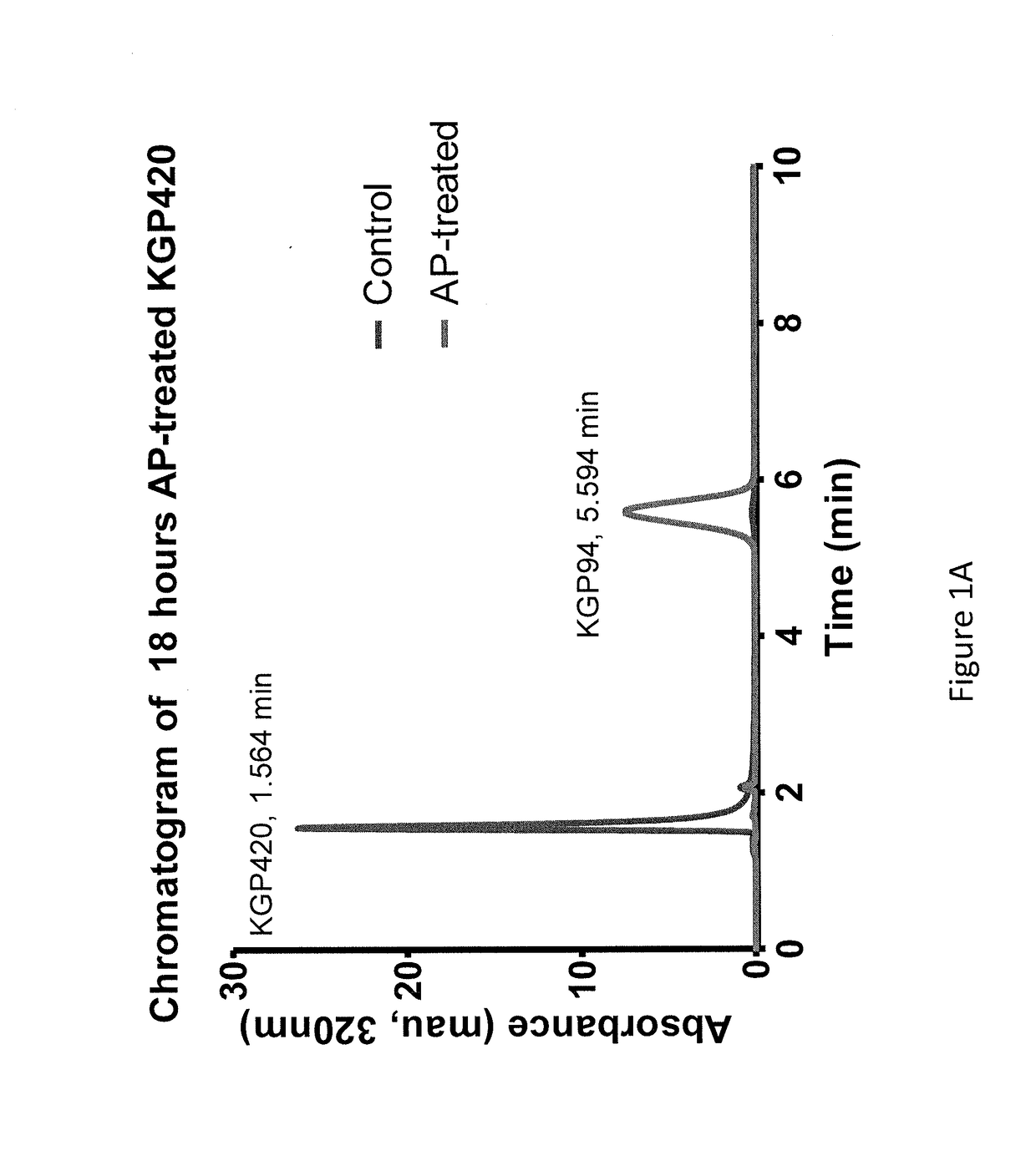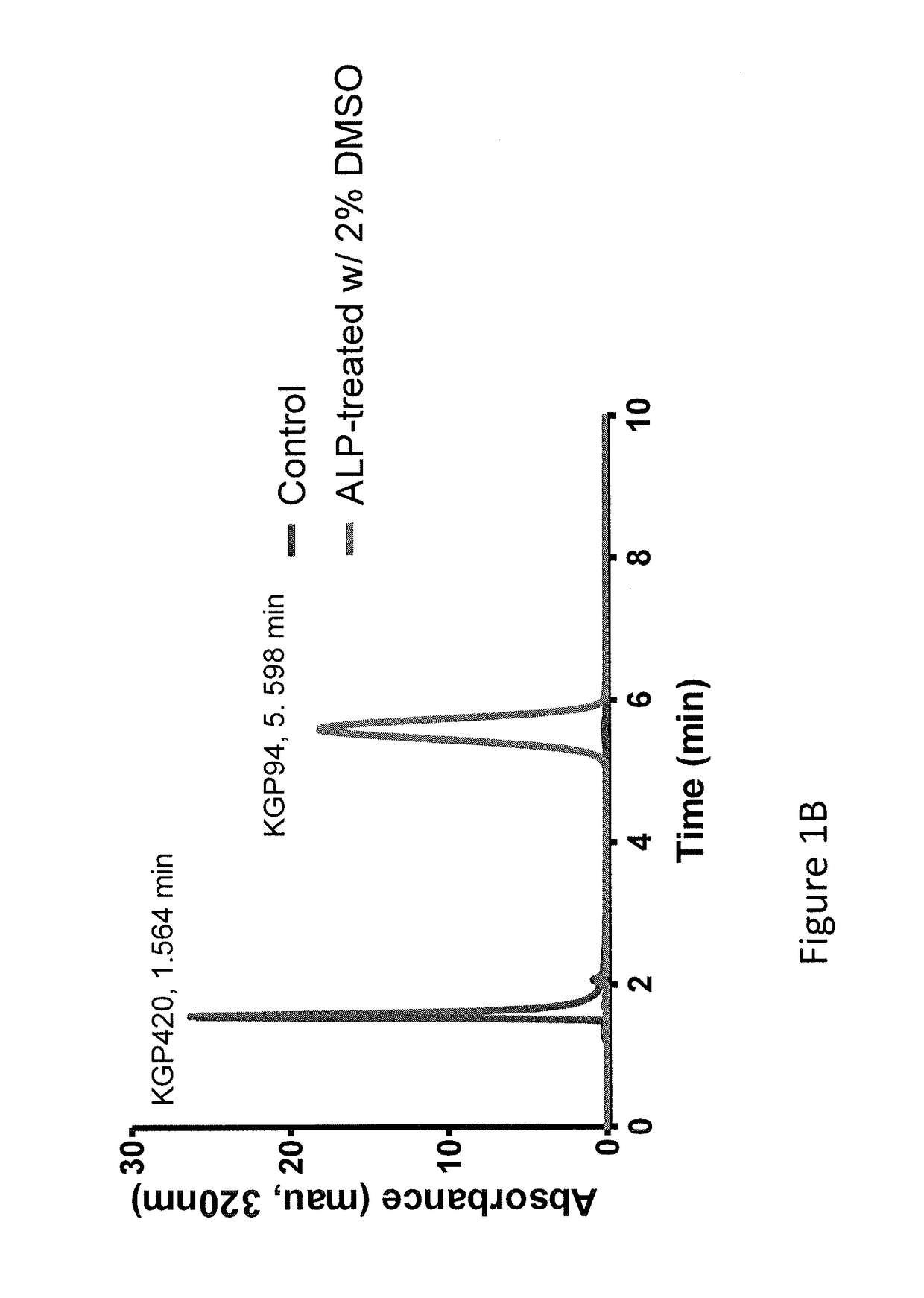Compositions and methods for inhibition of cathepsins
a technology of cathepsin and compound, applied in the field of compound and method for inhibiting cathepsin, can solve the problems of compound poor aqueous solubility, no clinical trials focused on testing the inhibitor of cathepsin l in cancer metastasis,
- Summary
- Abstract
- Description
- Claims
- Application Information
AI Technical Summary
Benefits of technology
Problems solved by technology
Method used
Image
Examples
example 1
of Compound 11 and Compound 27
[0152]Scheme 6 illustrates an example for a method to synthesize Compound 11 and Compound 27.
Synthesis of (3-Bromophenoxy)-tert-butyl-dimethyl-silane
[0153]
[0154]Tert-butyl dimethylsilyl chloride (3.150 g, 21.00 mmol) was added to a solution of imidazole (1.900 g, 27.94 mmol) and 3-bromophenol (1.520 mL, 14.01 mmol) in anhydrous DMF (40 mL) at 0° C. The reaction mixture was stirred for 6 hrs. Upon completion of the reaction, 5% aqueous NaHCO3 (20 ml) was added to the reaction mixture. The products were extracted with hexanes (2×50 mL) and concentrated under reduced pressure. Purification by flash column chromatography (silica gel, hexanes 100%) afforded (3-bromo-phenoxy)-tert-butyl-dimethyl-silane (3.905 g, 13.59 mmol, 97% yield) as a colorless oil. 1H NMR (500 MHz, CDCl3) δ 7.10-7.06 (2H, m), 7.01-7.00 (1H, m), 6.78-6.74 (1H, m), 0.98 (9H, s), 0.20 (6H, s). 13C NMR (125 MHz, CDCl3) δ156.67, 130.55, 124.61, 123.66, 122.61, 118.96, 25.75, 18.33, −4.32.
Syn...
example 2
of Compound 12
[0173]Scheme 7 illustrates an example of a method to synthesize Compound 12.
Synthesis of (3,5-dibromophenoxy)-tert-butyldimethylsilane
[0174]
[0175]3,5-dibromophenol (3.78 g, 15.0 mmol) was dissolved in N,N-dimethylformamide (45 mL) followed by the addition of imidazole (2.04 g, 30.0 mmol). The reaction mixture was cooled to 0° C. and tert-butyldimethylchlorosilane (3.37 g, 22.5 mmol) was added. The reaction mixture was returned to room temperature and stirred for 4 h. After reaction completion, the reaction mixture was quenched with saturated aqueous sodium bicarbonate (50 mL) and the product was extracted with hexanes (3×50 mL). The organic extracts were dried over anhydrous sodium sulfate and concentrated under reduced pressure. The crude mixture was purified using flash chromatography (silica gel, hexanes) to afford (3,5-dibromophenoxy)-tert-butyldimethylsilane (5.38 g, 14.7 mmol, 98%). 1H NMR (600 MHz, CDCl3): δ 7.26 (1H, t, J=1.7 Hz), 6.93 (2H, d, J=1.7 Hz), 0.97 (...
example 3
of Compound 13
[0188]Scheme 8 illustrates an example of a method to synthesize Compound 13.
Synthesis of 3-((tert-butyldimethylsilyl)oxy) benzaldehyde
[0189]
[0190]3-hydroxybenzaldehyde (2.000 g, 16.38 mmol) was dissolved in N,N-dimethylformamide (50 mL) followed by the addition of imidazole (2.227 g, 32.75 mmol). The reaction mixture was cooled to 0° C. and tert-butyldimethylchlorosilane (3.684 g, 24.56 mmol) was added. The reaction mixture was returned to room temperature and stirred for 4 h. After reaction completion, the reaction mixture was quenched with saturated aqueous sodium bicarbonate (50 mL) and the product was extracted with hexanes (2×50 mL). The organic extracts were dried over anhydrous sodium sulfate and concentrated under reduced pressure. The crude mixture was purified using flash chromatography (silica gel, hexanes:ethyl acetate, gradient, 100:00 to 90:10) to afford 3-((tert-Butyldimethylsilyl)oxy) benzaldehyde (3.568 g, 15.09 mmol, 92% yield). 1H NMR (500 MHz, CDCl3...
PUM
| Property | Measurement | Unit |
|---|---|---|
| Molar density | aaaaa | aaaaa |
| Molar density | aaaaa | aaaaa |
| Molar density | aaaaa | aaaaa |
Abstract
Description
Claims
Application Information
 Login to View More
Login to View More - R&D
- Intellectual Property
- Life Sciences
- Materials
- Tech Scout
- Unparalleled Data Quality
- Higher Quality Content
- 60% Fewer Hallucinations
Browse by: Latest US Patents, China's latest patents, Technical Efficacy Thesaurus, Application Domain, Technology Topic, Popular Technical Reports.
© 2025 PatSnap. All rights reserved.Legal|Privacy policy|Modern Slavery Act Transparency Statement|Sitemap|About US| Contact US: help@patsnap.com



